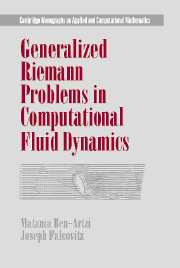Book contents
- Frontmatter
- Contents
- List of Figures
- Preface
- 1 Introduction
- I BASIC THEORY
- 2 Scalar Conservation Laws
- 3 The GRP Method for Scalar Conservation Laws
- 4 Systems of Conservation Laws
- 5 The Generalized Riemann Problem (GRP) for Compressible Fluid Dynamics
- 6 Analytical and Numerical Treatment of Fluid Dynamical Problems
- II NUMERICAL IMPLEMENTATION
- A Entropy Conditions for Scalar Conservation Laws
- B Convergence of the Godunov Scheme
- C Riemann Solver for a γ-Law Gas
- D The MUSCL Scheme
- Bibliography
- Glossary
- Index
5 - The Generalized Riemann Problem (GRP) for Compressible Fluid Dynamics
Published online by Cambridge University Press: 20 August 2009
- Frontmatter
- Contents
- List of Figures
- Preface
- 1 Introduction
- I BASIC THEORY
- 2 Scalar Conservation Laws
- 3 The GRP Method for Scalar Conservation Laws
- 4 Systems of Conservation Laws
- 5 The Generalized Riemann Problem (GRP) for Compressible Fluid Dynamics
- 6 Analytical and Numerical Treatment of Fluid Dynamical Problems
- II NUMERICAL IMPLEMENTATION
- A Entropy Conditions for Scalar Conservation Laws
- B Convergence of the Godunov Scheme
- C Riemann Solver for a γ-Law Gas
- D The MUSCL Scheme
- Bibliography
- Glossary
- Index
Summary
This chapter is concerned with the main topic of the monograph, namely, the solution of the GRP for quasi-1-D, inviscid, compressible, nonisentropic, time-dependent flow. In Section 5.1 we formulate the problem and study its solution in the Lagrangian and Eulerian frames. In particular, we state and prove the main ingredient in the GRP method, Theorem 5.7. A weaker form of this theorem leads to the “acoustic approximation” (Proposition 5.9). Summary 5.24 gives a step-by-step description of the GRP analysis. In Section 5.2 we present the GRP methodology for the construction of second-order, high-resolution finite-difference (or finite-volume) schemes. Starting out from the (first-order) Godunov scheme, we present the basic (E1) GRP scheme. It is based on the acoustic approximation and constitutes the simplest second-order extension of Godunov's scheme. This is followed by a presentation of the full array of GRP schemes (as well as MUSCL). Generally speaking, the presentation in this chapter follows closely the GRP papers [7] and [10].
The GRP for Quasi-1-D, Compressible, Inviscid Flow
In Section 4.2 we studied the Euler equations (4.45) governing the quasi-1-D flow in a duct of variable cross section. We emphasized in particular the role of the Riemann problem (“shock tube problem”), namely, the IVP subject to initial data (4.100). As we shall see in this chapter, the solution to the Riemann problem is a basic ingredient in the numerical resolution of the flow.
- Type
- Chapter
- Information
- Generalized Riemann Problems in Computational Fluid Dynamics , pp. 135 - 183Publisher: Cambridge University PressPrint publication year: 2003
- 1
- Cited by

